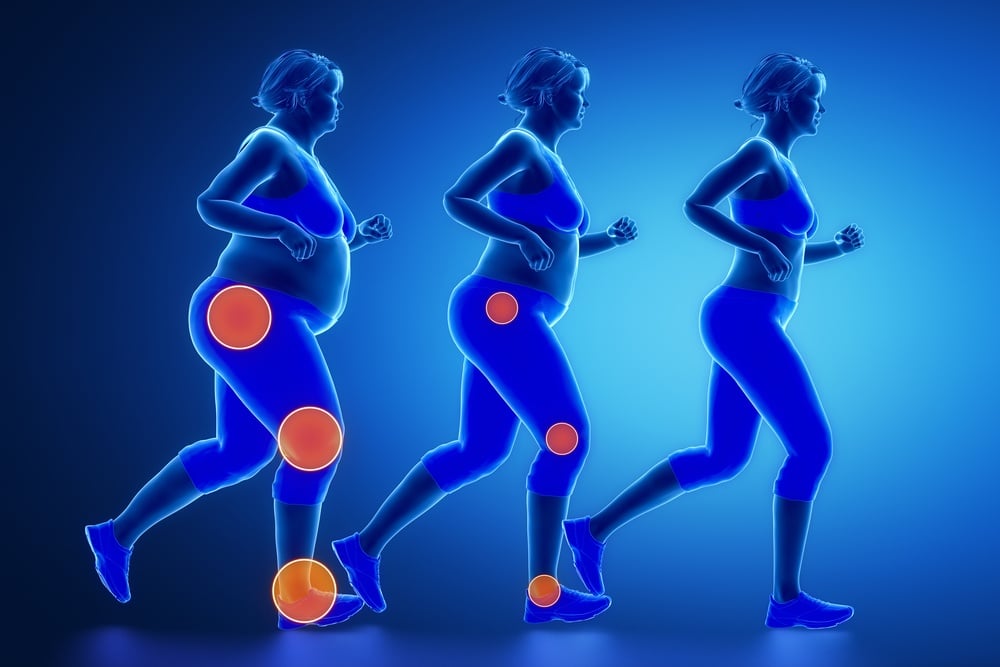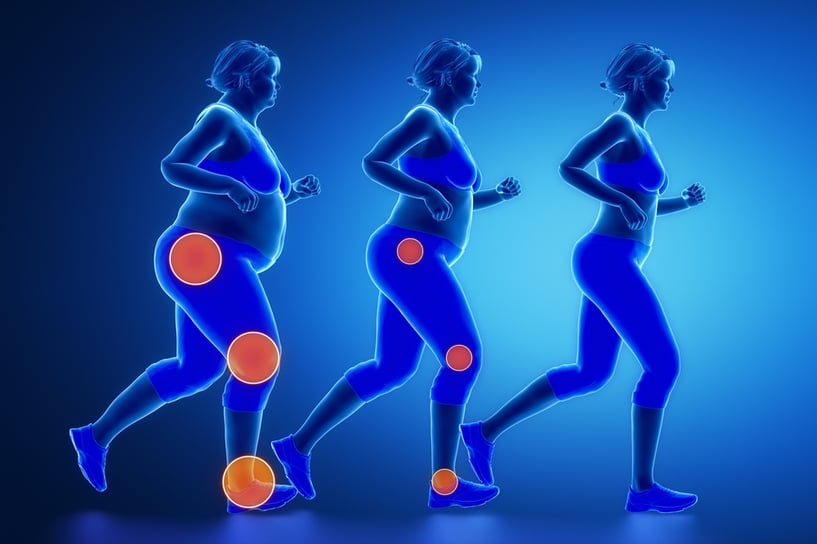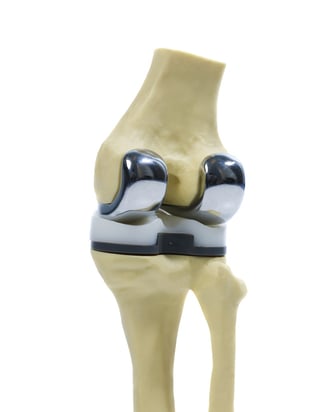How obesity increases joint damage
June 27th, 2016 | 4 min. read


Carrying extra weight can lead to aches and pains. But did you know that being overweight or obese can damage your joints permanently?
If you are overweight or obese, you may have noticed that your knees are creaky or sore. Perhaps your ankles swell or feel tight after walking. Maybe your hips hurt.
These symptoms are all possible signs of joint damage (most likely, osteoarthritis). Being heavy or obese increases your likelihood of getting arthritis, raising the risk from 1 in 5 — the typical risk of arthritis among Americans — to 1 in 3.
obesity and joint damage from arthritis
Osteoarthritis (OA)
Osteoarthritis is the breakdown of cartilage that covers the ends of the bones in your joints. The purpose of this cartilage is to pad the bones, allowing them to slide past each other smoothly without grinding.
Over time, aging causes this cartilage to break down from normal wear and tear, leading to friction between the bones that causes pain, stiffness, and a reduced range of motion. This condition, osteoarthritis (OA), affects about 27 million Americans.
The age of onset for OA varies, as does its severity. For most people with OA, it begins around middle age. However, certain lifestyles can lead to individuals getting osteoarthritis earlier or suffering from more severe cartilage breakdown.

Previous injuries, excessive wear and tear from athletics, heredity, and obesity can all contribute to a higher risk of developing osteoarthritis.
If you are obese, you are more likely to develop osteoarthritis. If you already have osteoarthritis, being obese will very likely make your arthritis worse.
Why does this happen?
- Mechanical stress. Added weight puts more pressure on your joints. Experts estimate that for every pound of extra weight you carry, your knees absorb an extra 4 pounds of pressure.
If you're 20 pounds overweight, for example, your knees are supporting 80 pounds of extra force with every step. If you're obese and carry 50 pounds of extra weight, the added pressure on the knees multiplies to 200 pounds.
This pressure adds up, increasing friction and causing premature damage to the cartilage in weight-bearing joints: the hips, the lower back, the knees, and the ankles. - Chemical and hormonal responses. Studies show that carrying more fat may trigger chemical reactions in the body that can worsen your arthritis symptoms. Excess fat tissue may release chemicals that trigger inflammatory responses, which can worsen OA symptoms like pain and swelling. Having a higher body mass index (BMI) is also associated with an increased presence of leptins in joint fluid, which may also promote inflammation.
Rheumatoid Arthritis (RA)
Obesity also plays a role in rheumatoid arthritis (RA). If you have RA, your body's immune system attacks your joint tissue, creating inflammation, joint pain, and erosion of cartilage.
In addition to the biomechanical stress on the joints from being heavy, fat tissue itself makes RA symptoms worse by releasing chemicals called cytokines, which increase joint inflammation.
obesity and other joint disorders
Obesity has also been linked to other inflammatory conditions that cause joint damage and joint pain, including:
Gout. Gout is caused by an increase of insulin in the body, which inhibits the ability of the kidneys to process uric acid. As a result, uric acid crystals build up in the joints, causing acute pain (usually in the big toe). About 70% of all people with gout are overweight, and the extremely obese are about ten times as likely to develop the condition as people who maintain a healthy weight.
Fibromyalgia. This pain disorder is characterized by tender points of inflammation throughout the body. Recent studies show that being obese and inactive increases one's risk of developing fibromyalgia. Heavier patients also experience more severe symptoms.
Lupus. People with the autoimmune disorder lupus experience joint inflammation that can make physical coordination and everyday activities difficult. Lupus patients with higher BMIs tend to experience higher levels of disability, largely because the fat tissue releases cytokines that trigger joint inflammation.
childhood obesity and joint damage
Obesity can affect children's joint health, too. Obese or overweight children carry extra weight that stresses their growth plates — the areas at the end of their long bones (arms and legs) that develop cartilage and regulate the length and shape of bones when they reach maturity. This excess stress can harm bone growth and the development of cartilage.
In addition, carrying too much weight leads to more impact on the bones and joints, which can lead to a greater than normal level of wear and tear. Obesity can also lead to hormonal imbalances, which may affect musculoskeletal growth. As a result, obese and overweight children can become prone to:
- flat feet, which can lead to difficulty standing and walking
- early onset arthritis, which may cause chronic pain, stiffness, mobility issues, and a need for joint surgery
- increased risk of bone breaks, which may be more difficult to stabilize and heal due to complications from obesity
- slipped capital femoral epiphysis, a hip disorder which can cause hips to slip out of place, leading to long-term hip or knee pain, a limp, or an inability to put weight on the leg; hips may require a surgical screw for stabilization
- Blount's disease, a growth deformity that causes a severe bowing of the legs; correction may require a leg brace, orthotics, or orthopedic surgery to remove a piece of bone from the tibia, straightening the leg
Obesity can have a serious impact on a child's physical development. If your child is overweight and you are worried, see a doctor. Reduced screen time, scheduled outdoor play, and a safe exercise and diet program can go a long way toward reducing the risk of joint damage in the future.

improving joint pain from obesity
Joint damage, once sustained, is not reversible. However, options are available to help improve joint pain and function.
Lose weight. If you can, start a gentle, low-impact exercise regimen to drop excess weight. Even a modest reduction in body mass can help to take some of the stress off your joints, helping you to feel and move better. One recent study showed that among obese older adults with osteoarthritis (OA), a weight loss of 5% boosted the participants' overall function by 18%.
See an orthopedic specialist. If your joint pain and mobility issues are chronic, an orthopedist can advise you about physical therapy, treatments, and surgery (for example, knee replacement or arthroscopy).
For more information, give Coastal Orthopedics in Corpus Christi, TX a call and ask for a consultation. Our experts can assess the condition of your joints and create a treatment plan that works for you. Telephone: 361.994.1166.
Article written by: Rob Williams, MD
Dr. Williams has been practicing orthopedic surgery in Corpus Christi since 1998. After graduating from Texas Tech hereceived his medical degree from the University of Texas at San Antonio. At the prestigious Campbell Clinic located at the University of Tennessee, Dr. Williams completed not only an Orthopedic Surgery Residency, but an additional year of Fellowship Training in Spine Surgery. Dr. Williams is dedicated to creating an excellent patient experience in the office or in the surgery suite.

